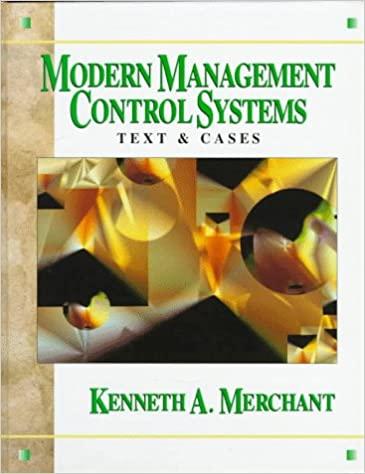Question
As the company began its post-Dave Thomas era, management thought that perhaps the time had come to give serious consideration to eliminating at least one
As the company began its post-Dave Thomas era, management thought that perhaps the time had come to give serious consideration to eliminating at least one of the original menu items. Of these, chili seemed to be the most likely candidate. In addition to being the menu maverick, chili represented a relatively small percentage of total restaurant sales, and there was considerable controversy over its true profit margin. The issue, it seemed, had to do with determining the actual cost of a bowl of chili. This same issue had, in fact, been debated but never resolved back in 1979 when Wendys salad bar was introduced. Thus, regardless of the ultimate menu decision, management was determined to figure out once and for all what a bowl of chili really cost.
Costing the Chili:
Wendys chili was prepared daily by the assistant manager, in accordance with Wendys secret recipe. It was slow-simmered in a double coiler on a separate range top for a period of four to six hours. While cooking, the chili had to be stirred at least once each hour, and at the end of the day it was refrigerated for sale the following day.
Normally it took between 10 and 15 minutes to prepare a pot (referred to at Wendys as a batch) of chili. First, the 48 quarter-pound cooked ground beef patties needed for a batch were obtained, if available, from the walk-in cooler. This took about one minute. These patties had been well-done sometime during the previous three days. Most of the time, it wasnt necessary to cook meat specifically for use in making chili although the need to do so was more likely to occur during the months of October through March when approximately 60% of total annual chili sales occurred. If, as only happened approximately 10% of the time, it became necessary to cook meat specifically for use in making chili, the number of beef patties needed were taken from the trays of uncooked hamburgers that had been prepared using a special patty machine, at the rate of 120 patties every five minutes, earlier that morning. On average, it took 10 minutes to cook 48 hamburger patties.
Before it was placed in the chili pot, the meat had to be chopped into small pieces. This generally took about five minutes to do. The remaining ingredients then had to be obtained from the shelves and mixed with the meat. This process also took about five minutes to complete, after which the chili was ready to be cooked. The quantities and costs of the ingredients needed to make a batch of chili and the labor costs associated with the different classifications of restaurant personnel are shown as follows. Other direct costs associated with the chili included serving bowls, $0.0035 each; lids for chili served at the carry-out window, $0.0025 each; and spoons, $0.01 each.
Chili ingredients and costs
Quantity Description Cost
1 No. 10 can of crushed tomatoes $2.75/can
5 46-oz. cans of tomato juice $1.25/can
1 Wendys seasoning packet $1.00/packet
2 No. 10 cans of red beans $2.25/can
48 Cooked quarter-pound ground beef patties
(12 lb. of ground beef) $3.50/lb.
Restaurant labor costs
Description Cost
Store Manager $800.00/week (salary)
Co-Manager $12.50/hour
Assistant Manager $10.50/hour
Management Trainee $7.00/hour
Crew $5.75/hour
Note: Payroll taxes and other employee-related costs averaged about 10% of above amounts
Chili Sales:
The selling prices for all Wendys products sold by company restaurants were set at corporate headquarters. Although some price differences existed among restaurants in different locations, representative pries for 2001 were $0.99 for an 8-oz. serving of chili, $1.59 for a 12-oz. serving of chili, and $1.89 for a single hamburger. Chili sales were seasonal, and comprised about 5% of total Wendys store sales compared with about 55% for hamburgers.
Wendys consolidated cost of sales as a percentage of retail revenues, increased to 63.8% in 2001 from 63.1% in 2000. Food costs in 2001 reflected a 13.4% increase in beef costs, which was partially offset by a 1.6% selling price increase. Retail sales increased by 6.5%, and net income increased by about 14% during 2001.
A) How much does a bowl of chili cost on a full-cost basis? An out-of-pocket basis?
B) For determining the true profitability of chili, how much does a bowl of chili really cost?
C) Would you recommend dropping chili from the menu? Why or why not?
Step by Step Solution
There are 3 Steps involved in it
Step: 1

Get Instant Access to Expert-Tailored Solutions
See step-by-step solutions with expert insights and AI powered tools for academic success
Step: 2

Step: 3

Ace Your Homework with AI
Get the answers you need in no time with our AI-driven, step-by-step assistance
Get Started


